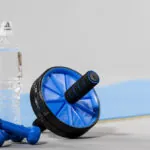The kettlebell sumo squat is a dynamic exercise that blends strength training with functional fitness. Ideal for both beginners and advanced athletes, this exercise targets multiple muscle groups, including the glutes, quads, hamstrings, and core. Incorporating kettlebell sumo squats into your workout routine can enhance your lower body strength, improve your posture, and boost your overall fitness. This article will guide you through the perfect form, safety guidelines, and variations to ensure you get the most out of this powerful exercise.
Step-by-step technique
To execute a kettlebell sumo squat correctly, follow these detailed steps:
- Initial positioning:
-
-
- Stand with your feet wider than shoulder-width apart, toes pointing slightly outward.
- Hold a kettlebell with both hands in front of you, arms extended downward.
- Keep your back straight and shoulders pulled back.
-
- The descent:
-
-
- Slowly bend your knees and lower your hips, as if sitting back into a chair.
- Ensure the kettlebell remains directly below your chest, close to your body.
- Lower yourself until your thighs are at least parallel to the ground, keeping your heels flat.
-
- The ascent:
-
-
- Push through your heels to rise back up to the starting position.
- Maintain a straight back and tight core throughout the movement.
- Exhale as you ascend, driving upward with your legs.
-
- Common mistakes to avoid:
-
- Avoid rounding your back or shrugging your shoulders.
- Keep the kettlebell stable and controlled to prevent swinging.
Safety guidelines
To perform kettlebell sumo squats safely and effectively, adhere to these guidelines:
- Proper form: Always prioritize form over weight. Incorrect form can lead to injuries, particularly in the back and knees.
- Weight handling: Start with a lighter weight to master the technique. Gradually increase the weight as you become more comfortable with the form.
- Contraindications: If you have existing knee or back issues, consult with a healthcare provider or a fitness professional before attempting this exercise.
Modifications and variations
Kettlebell sumo squats can be modified to suit different fitness levels and goals:
- For beginners: Start without a kettlebell or with a very light one. Focus on mastering the form with bodyweight squats or a lighter kettlebell.
- Advanced variations: Increase the kettlebell weight, or add a second kettlebell for added intensity. For an additional challenge, incorporate a press at the top of the squat.
- Alternatives for injuries: If you have lower body injuries, consider performing seated variations or using resistance bands for less impact.
Integrating into your workout routine
Successfully adding kettlebell sumo squats into your workout routine requires strategic planning:
- Warm-up: Begin with a general cardiovascular warm-up followed by dynamic stretching, focusing on the legs and hips.
- Combining exercises: Pair kettlebell sumo squats with upper-body exercises or cardiovascular drills for a balanced workout.
- Frequency and repetition: Start with two sessions per week, incorporating three sets of 10-12 repetitions. Adjust the frequency and volume as your strength and endurance improve.
To learn more about how kettlebell exercises can be integrated into your routine, contact our St Augustine personal trainers today.
Benefits of kettlebell sumo squats
Kettlebell sumo squats are a multifaceted exercise offering numerous benefits for individuals seeking to improve their fitness:
- Muscle groups targeted: This exercise primarily strengthens the lower body, including the glutes, quadriceps, hamstrings, and calves. Additionally, it engages the core muscles, which helps in improving stability and balance.
- Cardiovascular and strength benefits: Performing kettlebell sumo squats increases heart rate, promoting cardiovascular health. The exercise also enhances overall body strength and endurance.
- Impact on flexibility and balance: Regular practice of kettlebell sumo squats can improve flexibility in the hips and ankles. The exercise also boosts balance and coordination by engaging the core and lower body muscles in a dynamic way.
Common challenges and solutions
While kettlebell sumo squats are highly beneficial, they can present challenges, especially to those new to the exercise:
- Balancing difficulties:
-
- Solution: Focus on core strength exercises. Improving core stability helps in maintaining balance throughout the squatting motion.
- Increasing weight responsibly:
-
- Solution: Only increase the kettlebell weight when you can perform the current weight with perfect form through all sets and repetitions. Gradual progression is key to avoiding injury.
- Overcoming plateaus:
-
- Solution: Introduce variations, like the sumo squat high pull or sumo squat with twist, to challenge the muscles differently. Also, consider increasing the volume or intensity of your workouts periodically.
Final thoughts
The kettlebell sumo squat is an excellent exercise for enhancing strength, flexibility, and cardiovascular health. By following the correct techniques and incorporating the variations and safety guidelines provided, you can maximize the benefits while minimizing the risk of injury.





